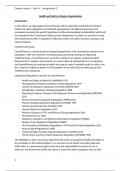Osman Yousuf – Unit 4 – Assignment 1
Health and Safety in Science Organisations
Introduction
In this report, an organisation (CymruPharma) will be inspected to determine if relevant
health and safety legislations are followed appropriately, the different processes and
procedures involving the specific legislations will be acknowledged and identified, which will
be compared to the Canterbury College Science Department, to obtain an overview in how
both departments differ in legislations followed, health and safety measures, protocol, and
vital procedures.
Context/Case Study:
CymruPharma is a pharmaceutical company/organisation, that manufactures drugs for the
population. They are involved in manufacturing, processing, testing and dispensing
medicinal drugs. CymruPharma are currently working on an organic compound called
Dilemmas’ll in a tackle to treat obesity. Its current route of administration is via injections,
and CymruPharma are working to modify the drug to make it available orally. In order to do
this, chlorine is added to aspirin (4-Chloroaspirin) to be able to join to other groups and
synthesise the compound.
Legislations/Regulations relevant to CymruPharma
- Health and Safety at Work Act (HASAWA) 1974
- Management of Health and Safety at Work Regulations 1999
- Control of Substances Hazardous to Health (COSHH) 2004
- Classification, Labelling, Packaging Regulation 2008
- Reporting of Injuries, Diseases and Dangerous Occurrences Regulations (RIDDOR)
2013
- Personal Protective Equipment Regulation (PPER) 2022
- Manual Handling Operations Regulations (MHOR) 1992
- Environmental Protection Act (EPA) 1990
- Human Medicines Regulations 2012
- Misuse of Drugs Act 1971 and Misuse of Drugs Regulations 2001
- The Medicines Act 1968
- Dangerous Substance and Explosive Atmosphere Regulation (DSEAR)
- Display Screen Equipment Regulations (DSER)
- Fire Precautions (Workplace) Regulations (1999) and Fire Safety Regulation 2022
- Noise at Work Regulations (1989)
- Control of Major Accident Hazards Regulations (COMAH) 2015
- The Provision and Use of Work Equipment Regulations (PUWER) 1998
The HASAWA is a piece of primary legislation that covers occupational Health and Safety in
the workplace in the United Kingdom. It is overseen by the Health and Safety Executive
(HSE) which is a government agency who have the responsibility to ensure the act is
enforced, and to promote health and safety. It covers the duties employers have to their
1
, Osman Yousuf – Unit 4 – Assignment 1
employees, as well as to members of the public, the duties employees have to themselves
and to other fellow employees,
Measures introduced for a safe working environment and safe workforce:
Under the HASAWA, employers have an obligation to ensure a safe workplace by ensuring all
equipment and machinery used is serviced, regularly checked to ensure no harm may come
to a worker using the equipment or machinery. A logbook or records must be kept being
used as evidence, which will have the dates of the servicing or checking, to show the
equipment or machinery is safe and functions correctly before use.
Employers have an obligation to ensure the correct training is provided, in all areas of work,
training will usually entail (depending on the work) skill development but must include a
safety training relating to use of equipment and machinery. Employees must be supervised
by a trained professional, and especially if management or employers feel as if training has
been inadequate. The employer or management is responsible for giving adequate training
before employees will be allowed to work individually and independently.
Employers or management are required to provide necessary personal protective
equipment, PPE differs depending on the area or type of work.
Employers or management are obligated to provide relevant information to employees, and
instructions that are given to employees must be in the best interests of the employee and
not cause any harm, or high risk, it is the responsibility of the employee for their actions
outside of instructions or information given, and it is the employees responsibility to adhere
and comply.
Employers have the responsibility to ensure overall health and safety is maintained and the
workplace remains safe, this can be achieved by carrying out detailed risk assessments for all
machinery, equipment, processes, hazards, or any other thing that may cause harm to the
workforce. The assessment must be clearly documented and clearly interpreted so
individuals can fully understand the hazard and risk. The risk should not be high/great, and if
so, the employer has the responsibility to introduce safety measures to lower risks. If the
risks have not changed, the hazard must be revaluated and the
equipment/machinery/procedure in question that causes a high risk must not be used or
carried out until deemed safe to do so. Employers must always consult to their employees
anything regarding health and safety, especially if it may cause harm to individuals. This is
the employers responsibility to clarify and highlight to ensure workers are protected against
anything that could harm them, and the employees responsibility to adhere to the
consultation instructions or information.
Employees have the responsibility to take care of the health and safety of themselves and
others who may be affected by their actions. Employees will consult and cooperate with
other employees, management, and employers regarding health and safety, especially if in
doubt or have concerns. It is the employees responsibility to wear protective clothing and
safety equipment provided by employers.
2




